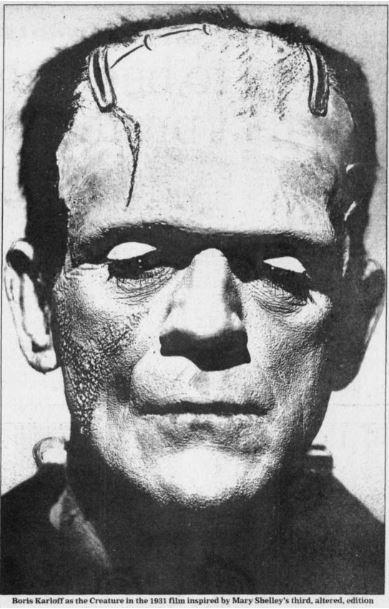│ By Tania Chakraborti, Gale Ambassador at Durham University │
The idea of what is monstrous has perhaps metamorphosed somewhat since the nineteenth century. Nowadays audiences root for the vampire (Netflix’s The Originals) sympathise with the werewolf (Twilight) or even cheer on the Devil (Netflix’s Lucifer). But in the time of Shelley, Verne and Stoker, monstrosity was far more complex (and far less American high school-orientated!)
One of the more obvious monsters of nineteenth-century literary tradition, and one which has frequented most A-Level English syllabuses, is Mary Shelley’s Frankenstein (1818) – a useful starting point when navigating the monstrous. Today we see the novel as a prime cautionary tale of nature versus nurture. The monster is to be pitied when he recounts his past solitude, and scorned when he takes the life of innocents; yet he is seen as an extension of humanity, not necessarily the “yellow” toothed “horror” that Frankenstein perceives him to be.
He is portrayed sympathetically in modern adaptations, where his womb-like creation in Branagh’s 1994 production highlights his overwhelmingly innocent, albeit sinister, genesis. However, that he is a “horror”-inducing creature is precisely what contemporary audiences of Shelley’s 1818 novel primarily noted. One 1823 stage adaptation, as can be read about via a critic’s observations in the Times Digital Archive, portrayed the creature’s features as “hideous from their discrepancy taken as a whole”. Instead of emphasising his initial confusion or innocence upon creation, this production shows his very “first act” to “rebel against his creator”, using the “immense strength with which he is endowed for every conceivable purpose of violence and evil”. Though some modern adaptations – such as the National Theatre Production (2012) – have attempted to show the creature’s progress to “evil” in stark ways (such as the implied rape of Elizabeth), his origin story is far purer and humanistic, something which was lost to early audiences in their more rigid categorisation of good and evil from inception. The creature was often perceived plain and simply as no more than a “monster.”

Yet audiences of the nineteenth century still recognised the monstrosity of humankind; such as in Frankenstein, in the creator’s desire to dominate, to unleash a power that ought to be reserved for a higher being. Such a dilemma as this and the “question of the monster” perplexed writers of the nineteenth century, particularly Jules Verne. In Twenty Thousand Leagues under the Sea (1870), a classic science fiction tale which fundamentally has sea monsters at its heart, Verne’s creature exhibits many parallels with Moby Dick’s fantastical whale. It is in Chapter Seven of Verne’s novel that professor Aronnax, his servant, and Ned Land, the harpooner, come face to face with a sea monster for the first time . Aronnax declares:
“There was no doubt about it! This monster, this natural phenomenon that had puzzled the learned world, and overthrown and misled the imagination of seamen of both hemispheres, was, it must be owned, a still more astonishing phenomenon, in as much as it was a simply human construction.” 1
This initial reaction to own the creature signifies to some critics the monstrous qualities of humankind in their cruel scientific curiosity; the monster is a vehicle through which the nineteenth century as an age of discovery can be characterised. However in 1998 in the journal Extrapolation, Carter Caplan saw the issue of monstrosity as very different, citing Verne’s purpose as not moral but largely scientific; “Verne shows us how we might take up the mantle of Jonah, enter the monster, and exploit the experience to positive ends”. Gale Literary Sources holds a wealth of critical essays such as this on the issue of monstrosity in Verne’s work.
Bram Stoker’s Dracula (1897), one of the most famous horror stories of the nineteenth century, saw mixed reactions in accordance with its tale of bloodlust, gender subversion and murder. It was heralded as “a striking example of imaginative power,” according to one critic in The Morning Post and even then was marked as “weird” and gruesome” by regional papers up and down the country. Indeed, such a sentiment is observable today, through the consistent remaking’s of adaptations from mostly faithful works such as Hollywood’s 1931 Dracula, to quirky spin-offs such as Waititi’s What We Do in the Shadows (2014). Why Dracula simply won’t die in the public imagination is a topic neatly handled by critic Mathias Clasen in his critical essay found in Gale Literary Sources. Clasen concludes aptly that “the vampire will presumably change even more in the future, but it is unlikely ever to find peace. It is simply too effective at what it does to stay put below ground. And what it does is play on evolved dispositions in its audience.”


Indeed, the “imaginative power” of Stoker’s work can be extended to the idea of modern monstrosity; from Twilight’s Edward Cullen to The Original’s Klaus Nicholson, their seductive qualities find their roots in the nineteenth century, when the monstrous was as enticing as it was frightening.

Blog post cover image citation: Butler, Marilyn, and Michael Arbib. “How to Make a Monster.” Daily Telegraph, 2 Nov. 1994, p. 16. The Telegraph Historical Archive, http://link.galegroup.com/apps/doc/IO0701341475/GDCS?u=webdemo&sid=GDCS&xid=c6ffa7a7
- Jules Verne, Twenty Thousand Leagues Under the Sea, 1870, quoted in Carter Kaplan “Jules Verne, Herman Melville, and the ‘question of the monster.’ (19th-century French science fiction author; 19th-century American author).” Extrapolation, vol. 39, no. 2, 1998, p. 139+. Literature Resource Center, http://link.galegroup.com./apps/doc/A20913299/GLS?u=duruni&sid=GLS&xid=b7d34d94

